Paper Menu >>
Journal Menu >>
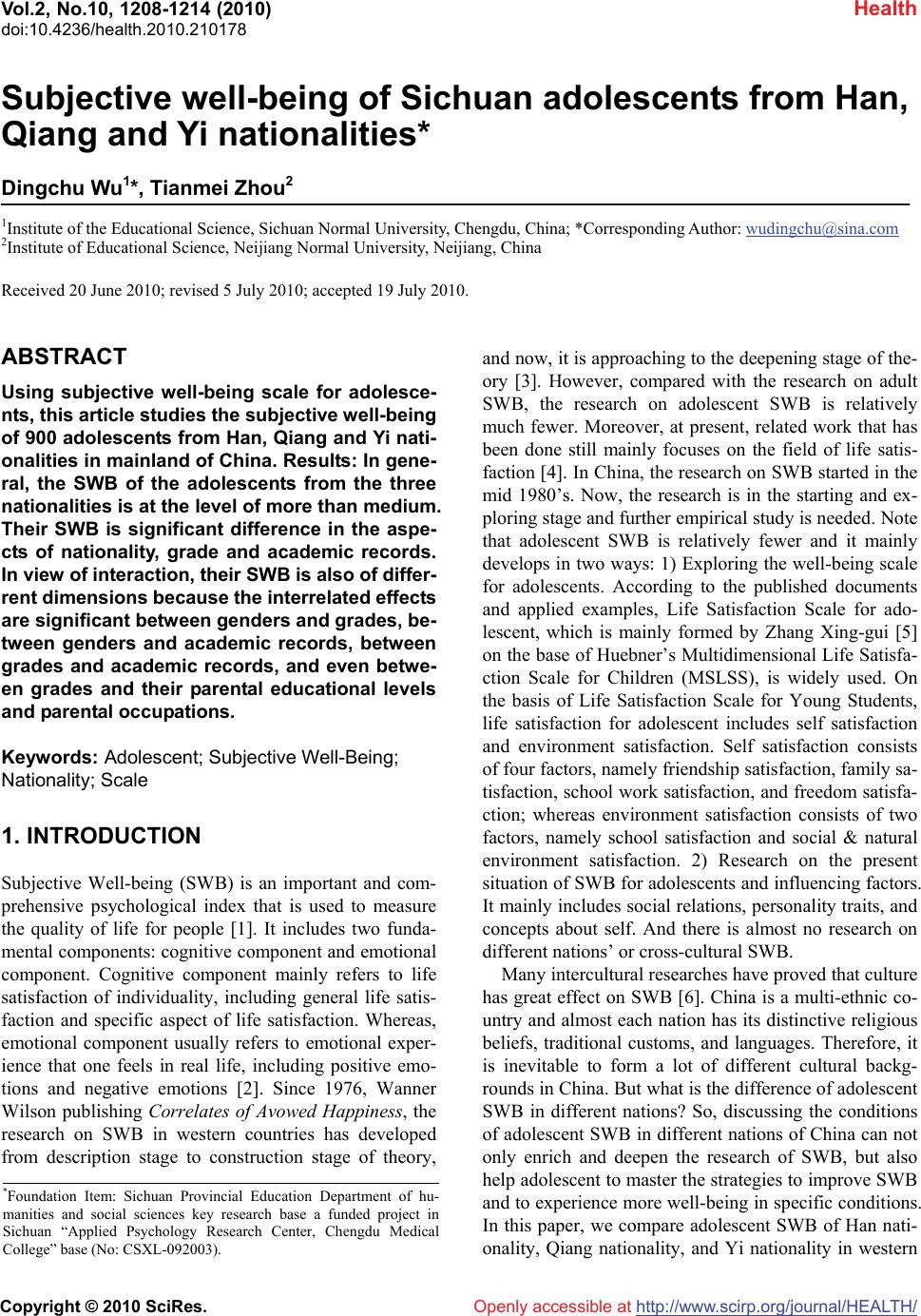 Vol.2, No.10, 1208-1214 (2010) Health doi:10.4236/health.2010.210178 Copyright © 2010 SciRes. Openly accessible at http://www.scirp.org/journal/HEALTH/ Subjective well-being of Sichuan adolescents from Han, Qiang and Yi nationalities* Dingchu Wu1*, Tianmei Zhou2 1Institute of the Educational Science, Sichuan Normal University, Chengdu, China; *Corresponding Author: wudingchu@sina.com 2Institute of Educational Science, Neijiang Normal University, Neijiang, China Received 20 June 2010; revised 5 July 2010; accepted 19 July 2010. ABSTRACT Using subjective well-being scale for adolesce- nts, this article studies the subjective well-being of 900 adolescents from Han, Qiang and Yi nati- onalities in mainland of China. Results: In gene- ral, the SWB of the adolescents from the three nationalities is at the level of more than medium. Their SWB is significant difference in the aspe- cts of nationality, grade and academic records. In view of interaction, their SWB is also of differ- rent dimensions because the interrelated effects are significant between genders and grades, be- tween genders and academic records, between grades and academic records, and even betwe- en grades and their parental educational levels and parental occupations. Keywords: Adolescent; Subjective Well-Being; Nationality; Scale 1. INTRODUCTION Subjective Well-being (SWB) is an important and com- prehensive psychological index that is used to measure the quality of life for people [1]. It includes two funda- mental components: cognitive component and emotional component. Cognitive component mainly refers to life satisfaction of individuality, including general life satis- faction and specific aspect of life satisfaction. Whereas, emotional component usually refers to emotional exper- ience that one feels in real life, including positive emo- tions and negative emotions [2]. Since 1976, Wanner Wilson publishing Correlates of Avowed Happiness, the research on SWB in western countries has developed from description stage to construction stage of theory, and now, it is approaching to the deepening stage of the- ory [3]. However, compared with the research on adult SWB, the research on adolescent SWB is relatively much fewer. Moreover, at present, related work that has been done still mainly focuses on the field of life satis- faction [4]. In China, the research on SWB started in the mid 1980’s. Now, the research is in the starting and ex- ploring stage and further empirical study is needed. Note that adolescent SWB is relatively fewer and it mainly develops in two ways: 1) Exploring the well-being scale for adolescents. According to the published documents and applied examples, Life Satisfaction Scale for ado- lescent, which is mainly formed by Zhang Xing-gui [5] on the base of Huebner’s Multidimensional Life Satisfa- ction Scale for Children (MSLSS), is widely used. On the basis of Life Satisfaction Scale for Young Students, life satisfaction for adolescent includes self satisfaction and environment satisfaction. Self satisfaction consists of four factors, namely friendship satisfaction, family sa- tisfaction, school work satisfaction, and freedom satisfa- ction; whereas environment satisfaction consists of two factors, namely school satisfaction and social & natural environment satisfaction. 2) Research on the present situation of SWB for adolescents and influencing factors. It mainly includes social relations, personality traits, and concepts about self. And there is almost no research on different nations’ or cross-cultural SWB. Many intercultural researches have proved that culture has great effect on SWB [6]. China is a multi-ethnic co- untry and almost each nation has its distinctive religious beliefs, traditional customs, and languages. Therefore, it is inevitable to form a lot of different cultural backg- rounds in China. But what is the difference of adolescent SWB in different nations? So, discussing the conditions of adolescent SWB in different nations of China can not only enrich and deepen the research of SWB, but also help adolescent to master the strategies to improve SWB and to experience more well-being in specific conditions. In this paper, we compare adolescent SWB of Han nati- onality, Qiang nationality, and Yi nationality in western *Foundation Item: Sichuan Provincial Education Department of hu- manities and social sciences key research base a funded project in Sichuan “Applied Psychology Research Center, Chengdu Medical College” base (No: CSXL-092003). 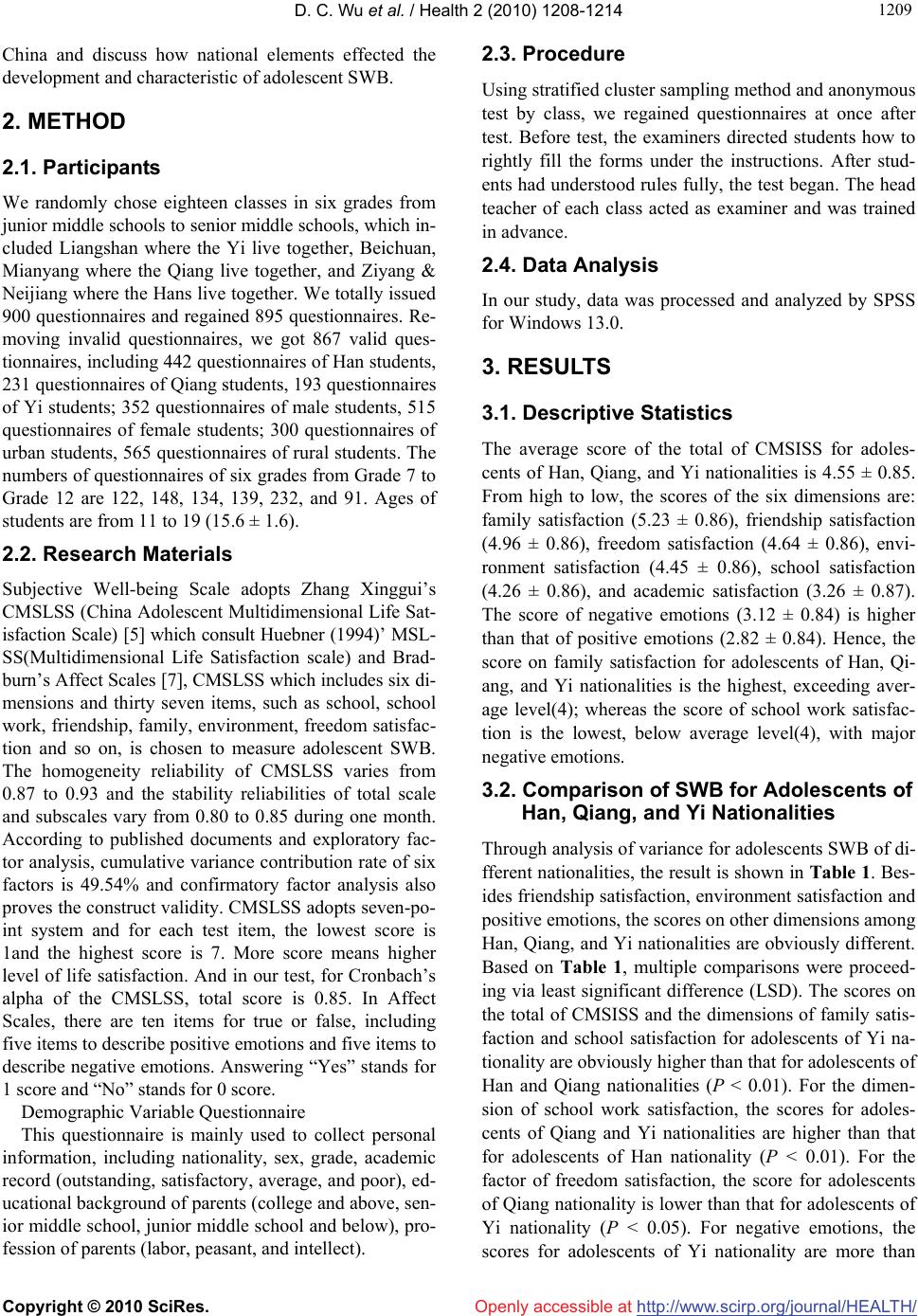 D. C. Wu et al. / Health 2 (2010) 1208-1214 Copyright © 2010 SciRes. Openly accessible at http://www.scirp.org/journal/HEALTH/ 120 1209 China and discuss how national elements effected the development and characteristic of adolescent SWB. 2. METHOD 2.1. Participants We randomly chose eighteen classes in six grades from junior middle schools to senior middle schools, which in- cluded Liangshan where the Yi live together, Beichuan, Mianyang where the Qiang live together, and Ziyang & Neijiang where the Hans live together. We totally issued 900 questionnaires and regained 895 questionnaires. Re- moving invalid questionnaires, we got 867 valid ques- tionnaires, including 442 questionnaires of Han students, 231 questionnaires of Qiang students, 193 questionnaires of Yi students; 352 questionnaires of male students, 515 questionnaires of female students; 300 questionnaires of urban students, 565 questionnaires of rural students. The numbers of questionnaires of six grades from Grade 7 to Grade 12 are 122, 148, 134, 139, 232, and 91. Ages of students are from 11 to 19 (15.6 ± 1.6). 2.2. Research Materials Subjective Well-being Scale adopts Zhang Xinggui’s CMSLSS (China Adolescent Multidimensional Life Sat- isfaction Scale) [5] which consult Huebner (1994)’ MSL- SS(Multidimensional Life Satisfaction scale) and Brad- burn’s Affect Scales [7], CMSLSS which includes six di- mensions and thirty seven items, such as school, school work, friendship, family, environment, freedom satisfac- tion and so on, is chosen to measure adolescent SWB. The homogeneity reliability of CMSLSS varies from 0.87 to 0.93 and the stability reliabilities of total scale and subscales vary from 0.80 to 0.85 during one month. According to published documents and exploratory fac- tor analysis, cumulative variance contribution rate of six factors is 49.54% and confirmatory factor analysis also proves the construct validity. CMSLSS adopts seven-po- int system and for each test item, the lowest score is 1and the highest score is 7. More score means higher level of life satisfaction. And in our test, for Cronbach’s alpha of the CMSLSS, total score is 0.85. In Affect Scales, there are ten items for true or false, including five items to describe positive emotions and five items to describe negative emotions. Answering “Yes” stands for 1 score and “No” stands for 0 score. Demographic Variable Questionnaire This questionnaire is mainly used to collect personal information, including nationality, sex, grade, academic record (outstanding, satisfactory, average, and poor), ed- ucational background of parents (college and above, sen- ior middle school, junior middle school and below), pro- fession of parents (labor, peasant, and intellect). 2.3. Procedure Using stratified cluster sampling method and anonymous test by class, we regained questionnaires at once after test. Before test, the examiners directed students how to rightly fill the forms under the instructions. After stud- ents had understood rules fully, the test began. The head teacher of each class acted as examiner and was trained in advance. 2.4. Data Analysis In our study, data was processed and analyzed by SPSS for Windows 13.0. 3. RESULTS 3.1. Descriptive Statistics The average score of the total of CMSISS for adoles- cents of Han, Qiang, and Yi nationalities is 4.55 ± 0.85. From high to low, the scores of the six dimensions are: family satisfaction (5.23 ± 0.86), friendship satisfaction (4.96 ± 0.86), freedom satisfaction (4.64 ± 0.86), envi- ronment satisfaction (4.45 ± 0.86), school satisfaction (4.26 ± 0.86), and academic satisfaction (3.26 ± 0.87). The score of negative emotions (3.12 ± 0.84) is higher than that of positive emotions (2.82 ± 0.84). Hence, the score on family satisfaction for adolescents of Han, Qi- ang, and Yi nationalities is the highest, exceeding aver- age level(4); whereas the score of school work satisfac- tion is the lowest, below average level(4), with major negative emotions. 3.2. Comparison of SWB for Adolescents of Han, Qiang, and Yi Nationalities Through analysis of variance for adolescents SWB of di- fferent nationalities, the result is shown in Table 1. Bes- ides friendship satisfaction, environment satisfaction and positive emotions, the scores on other dimensions among Han, Qiang, and Yi nationalities are obviously different. Based on Table 1, multiple comparisons were proceed- ing via least significant difference (LSD). The scores on the total of CMSISS and the dimensions of family satis- faction and school satisfaction for adolescents of Yi na- tionality are obviously higher than that for adolescents of Han and Qiang nationalities (P < 0.01). For the dimen- sion of school work satisfaction, the scores for adoles- cents of Qiang and Yi nationalities are higher than that for adolescents of Han nationality (P < 0.01). For the factor of freedom satisfaction, the score for adolescents of Qiang nationality is lower than that for adolescents of Yi nationality (P < 0.05). For negative emotions, the scores for adolescents of Yi nationality are more than 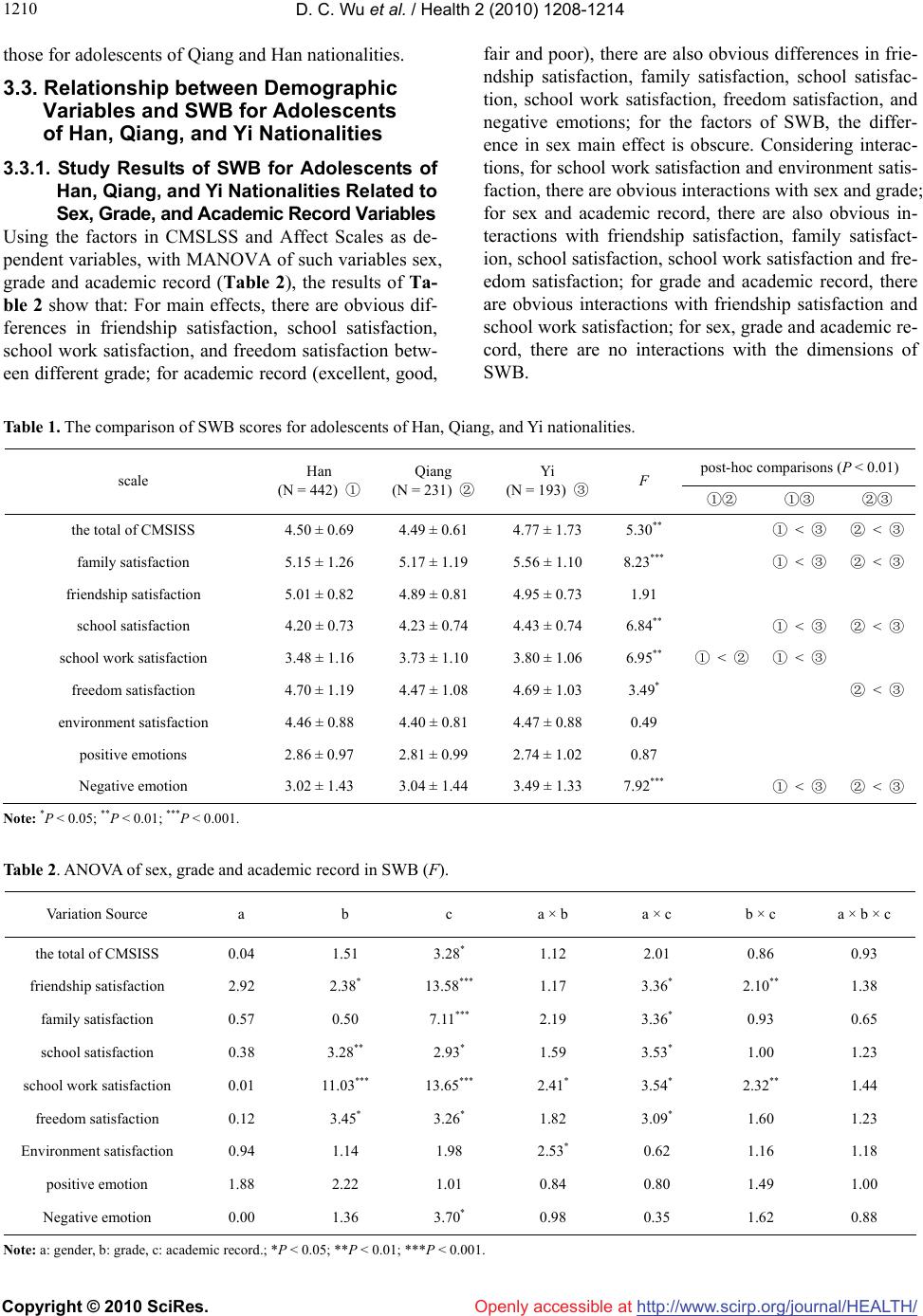 D. C. Wu et al. / Health 2 (2010) 1208-1214 Copyright © 2010 SciRes. Openly accessible at http://www.scirp.org/journal/HEALTH/ 1210 those for adolescents of Qiang and Han nationalities. 3.3. Relationship between Demographic Variables and SWB for Adolescents of Han, Qiang, and Yi Nationalities 3.3.1. Study Results of SWB for Adolescents of Han, Qiang, and Yi Nationalities Related to Sex, Grade, and Academic Record Variables Using the factors in CMSLSS and Affect Scales as de- pendent variables, with MANOVA of such variables sex, grade and academic record (Table 2), the results of Ta- ble 2 show that: For main effects, there are obvious dif- ferences in friendship satisfaction, school satisfaction, school work satisfaction, and freedom satisfaction betw- een different grade; for academic record (excellent, good, fair and poor), there are also obvious differences in frie- ndship satisfaction, family satisfaction, school satisfac- tion, school work satisfaction, freedom satisfaction, and negative emotions; for the factors of SWB, the differ- ence in sex main effect is obscure. Considering interac- tions, for school work satisfaction and environment satis- faction, there are obvious interactions with sex and grade; for sex and academic record, there are also obvious in- teractions with friendship satisfaction, family satisfact- ion, school satisfaction, school work satisfaction and fre- edom satisfaction; for grade and academic record, there are obvious interactions with friendship satisfaction and school work satisfaction; for sex, grade and academic re- cord, there are no interactions with the dimensions of SWB. Table 1. The comparison of SWB scores for adolescents of Han, Qiang, and Yi nationalities. post-hoc comparisons (P < 0.01) scale Han (N = 442) ① Qiang (N = 231) ② Yi (N = 193) ③ F ①② ①③ ②③ the total of CMSISS 4.50 ± 0.69 4.49 ± 0.61 4.77 ± 1.73 5.30** ① < ③ ② < ③ family satisfaction 5.15 ± 1.26 5.17 ± 1.19 5.56 ± 1.10 8.23*** ① < ③ ② < ③ friendship satisfaction 5.01 ± 0.82 4.89 ± 0.81 4.95 ± 0.73 1.91 school satisfaction 4.20 ± 0.73 4.23 ± 0.74 4.43 ± 0.74 6.84** ① < ③ ② < ③ school work satisfaction 3.48 ± 1.16 3.73 ± 1.10 3.80 ± 1.06 6.95** ① < ② ① < ③ freedom satisfaction 4.70 ± 1.19 4.47 ± 1.08 4.69 ± 1.03 3.49* ② < ③ environment satisfaction 4.46 ± 0.88 4.40 ± 0.81 4.47 ± 0.88 0.49 positive emotions 2.86 ± 0.97 2.81 ± 0.99 2.74 ± 1.02 0.87 Negative emotion 3.02 ± 1.43 3.04 ± 1.44 3.49 ± 1.33 7.92*** ① < ③ ② < ③ Note: *P < 0.05; **P < 0.01; ***P < 0.001. Table 2. ANOVA of sex, grade and academic record in SWB (F). Variation Source a b c a × b a × c b × c a × b × c the total of CMSISS 0.04 1.51 3.28* 1.12 2.01 0.86 0.93 friendship satisfaction 2.92 2.38* 13.58*** 1.17 3.36* 2.10** 1.38 family satisfaction 0.57 0.50 7.11*** 2.19 3.36* 0.93 0.65 school satisfaction 0.38 3.28** 2.93* 1.59 3.53* 1.00 1.23 school work satisfaction 0.01 11.03*** 13.65*** 2.41* 3.54* 2.32** 1.44 freedom satisfaction 0.12 3.45* 3.26* 1.82 3.09* 1.60 1.23 Environment satisfaction 0.94 1.14 1.98 2.53* 0.62 1.16 1.18 positive emotion 1.88 2.22 1.01 0.84 0.80 1.49 1.00 Negative emotion 0.00 1.36 3.70* 0.98 0.35 1.62 0.88 Note: a: gender, b: grade, c: academic record.; *P < 0.05; **P < 0.01; ***P < 0.001. 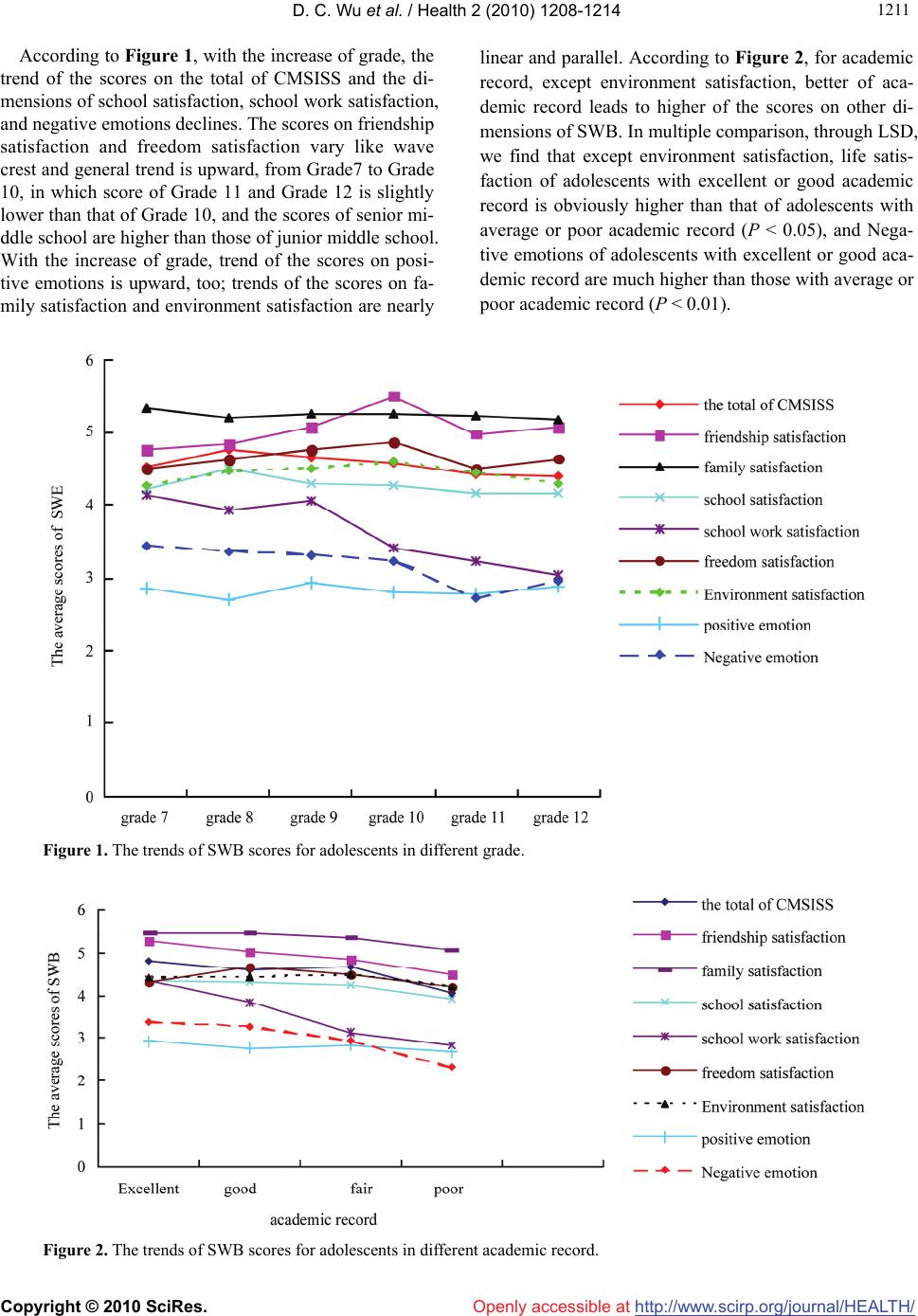 D. C. Wu et al. / Health 2 (2010) 1208-1214 Copyright © 2010 SciRes. Openly accessible at http://www.scirp.org/journal/HEALTH/ 121 1211 According to Figure 1, with the increase of grade, the trend of the scores on the total of CMSISS and the di- mensions of school satisfaction, school work satisfaction, and negative emotions declines. The scores on friendship satisfaction and freedom satisfaction vary like wave crest and general trend is upward, from Grade7 to Grade 10, in which score of Grade 11 and Grade 12 is slightly lower than that of Grade 10, and the scores of senior mi- ddle school are higher than those of junior middle school. With the increase of grade, trend of the scores on posi- tive emotions is upward, too; trends of the scores on fa- mily satisfaction and environment satisfaction are nearly linear and parallel. According to Figure 2, for academic record, except environment satisfaction, better of aca- demic record leads to higher of the scores on other di- mensions of SWB. In multiple comparison, through LSD, we find that except environment satisfaction, life satis- faction of adolescents with excellent or good academic record is obviously higher than that of adolescents with average or poor academic record (P < 0.05), and Nega- tive emotions of adolescents with excellent or good aca- demic record are much higher than those with average or poor academic record (P < 0.01). Figure 1. The trends of SWB scores for adolescents in different grade. Figure 2. The trends of SWB scores for adolescents in different academic record. 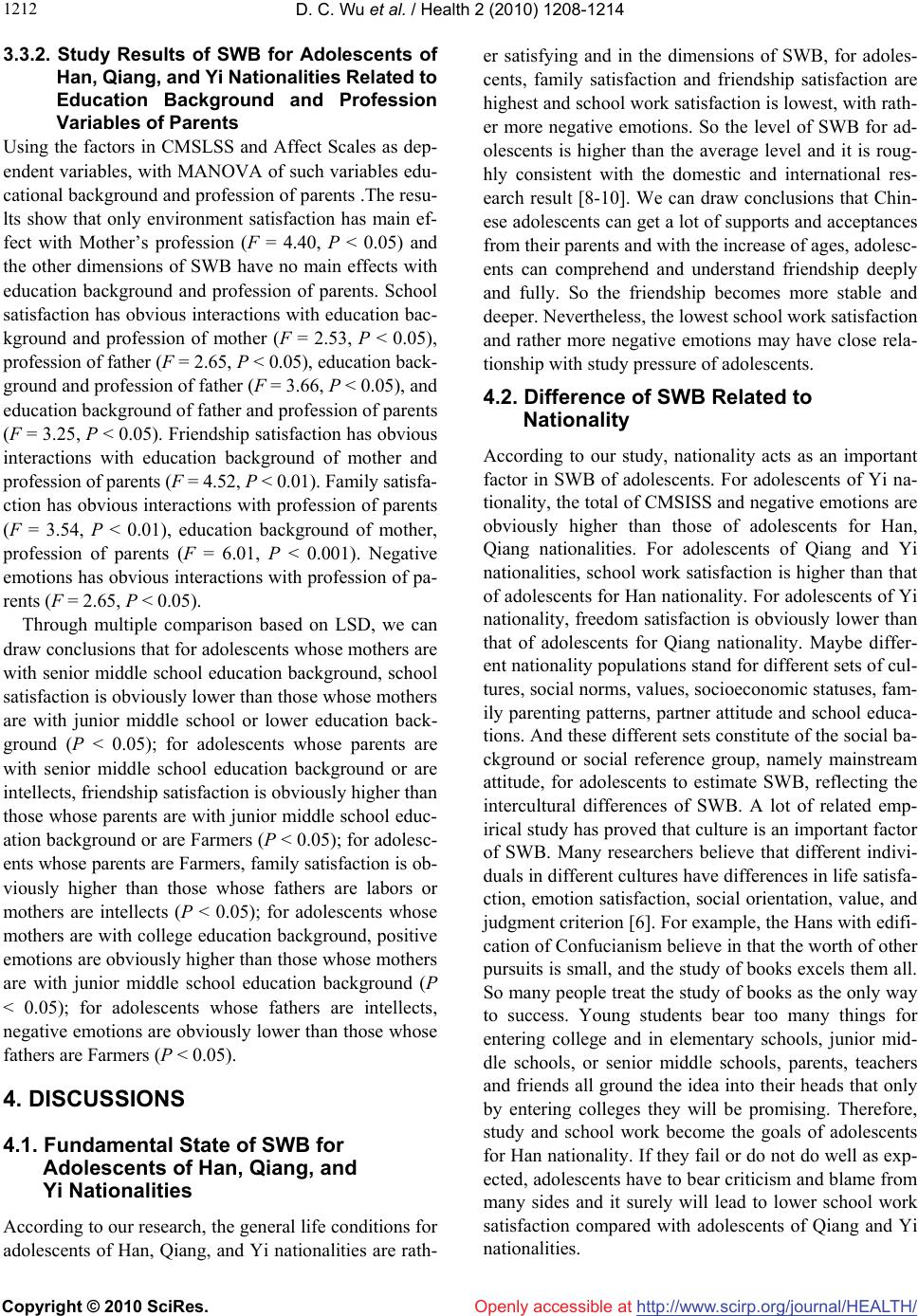 D. C. Wu et al. / Health 2 (2010) 1208-1214 Copyright © 2010 SciRes. Openly accessible at http://www.scirp.org/journal/HEALTH/ 1212 3.3.2. Study Results of SWB for Adolescents of Han, Qiang, and Yi Nationalities Related to Education Background and Profession Variables of Parents Using the factors in CMSLSS and Affect Scales as dep- endent variables, with MANOVA of such variables edu- cational background and profession of parents .The resu- lts show that only environment satisfaction has main ef- fect with Mother’s profession (F = 4.40, P < 0.05) and the other dimensions of SWB have no main effects with education background and profession of parents. School satisfaction has obvious interactions with education bac- kground and profession of mother (F = 2.53, P < 0.05), profession of father (F = 2.65, P < 0.05), education back- ground and profession of father (F = 3.66, P < 0.05), and education background of father and profession of parents (F = 3.25, P < 0.05). Friendship satisfaction has obvious interactions with education background of mother and profession of parents (F = 4.52, P < 0.01). Family satisfa- ction has obvious interactions with profession of parents (F = 3.54, P < 0.01), education background of mother, profession of parents (F = 6.01, P < 0.001). Negative emotions has obvious interactions with profession of pa- rents (F = 2.65, P < 0.05). Through multiple comparison based on LSD, we can draw conclusions that for adolescents whose mothers are with senior middle school education background, school satisfaction is obviously lower than those whose mothers are with junior middle school or lower education back- ground (P < 0.05); for adolescents whose parents are with senior middle school education background or are intellects, friendship satisfaction is obviously higher than those whose parents are with junior middle school educ- ation background or are Farmers (P < 0.05); for adolesc- ents whose parents are Farmers, family satisfaction is ob- viously higher than those whose fathers are labors or mothers are intellects (P < 0.05); for adolescents whose mothers are with college education background, positive emotions are obviously higher than those whose mothers are with junior middle school education background (P < 0.05); for adolescents whose fathers are intellects, negative emotions are obviously lower than those whose fathers are Farmers (P < 0.05). 4. DISCUSSIONS 4.1. Fundamental State of SWB for Adolescents of Han, Qiang, and Yi Nationalities According to our research, the general life conditions for adolescents of Han, Qiang, and Yi nationalities are rath- er satisfying and in the dimensions of SWB, for adoles- cents, family satisfaction and friendship satisfaction are highest and school work satisfaction is lowest, with rath- er more negative emotions. So the level of SWB for ad- olescents is higher than the average level and it is roug- hly consistent with the domestic and international res- earch result [8-10]. We can draw conclusions that Chin- ese adolescents can get a lot of supports and acceptances from their parents and with the increase of ages, adolesc- ents can comprehend and understand friendship deeply and fully. So the friendship becomes more stable and deeper. Nevertheless, the lowest school work satisfaction and rather more negative emotions may have close rela- tionship with study pressure of adolescents. 4.2. Difference of SWB Related to Nationality According to our study, nationality acts as an important factor in SWB of adolescents. For adolescents of Yi na- tionality, the total of CMSISS and negative emotions are obviously higher than those of adolescents for Han, Qiang nationalities. For adolescents of Qiang and Yi nationalities, school work satisfaction is higher than that of adolescents for Han nationality. For adolescents of Yi nationality, freedom satisfaction is obviously lower than that of adolescents for Qiang nationality. Maybe differ- ent nationality populations stand for different sets of cul- tures, social norms, values, socioeconomic statuses, fam- ily parenting patterns, partner attitude and school educa- tions. And these different sets constitute of the social ba- ckground or social reference group, namely mainstream attitude, for adolescents to estimate SWB, reflecting the intercultural differences of SWB. A lot of related emp- irical study has proved that culture is an important factor of SWB. Many researchers believe that different indivi- duals in different cultures have differences in life satisfa- ction, emotion satisfaction, social orientation, value, and judgment criterion [6]. For example, the Hans with edifi- cation of Confucianism believe in that the worth of other pursuits is small, and the study of books excels them all. So many people treat the study of books as the only way to success. Young students bear too many things for entering college and in elementary schools, junior mid- dle schools, or senior middle schools, parents, teachers and friends all ground the idea into their heads that only by entering colleges they will be promising. Therefore, study and school work become the goals of adolescents for Han nationality. If they fail or do not do well as exp- ected, adolescents have to bear criticism and blame from many sides and it surely will lead to lower school work satisfaction compared with adolescents of Qiang and Yi nationalities. 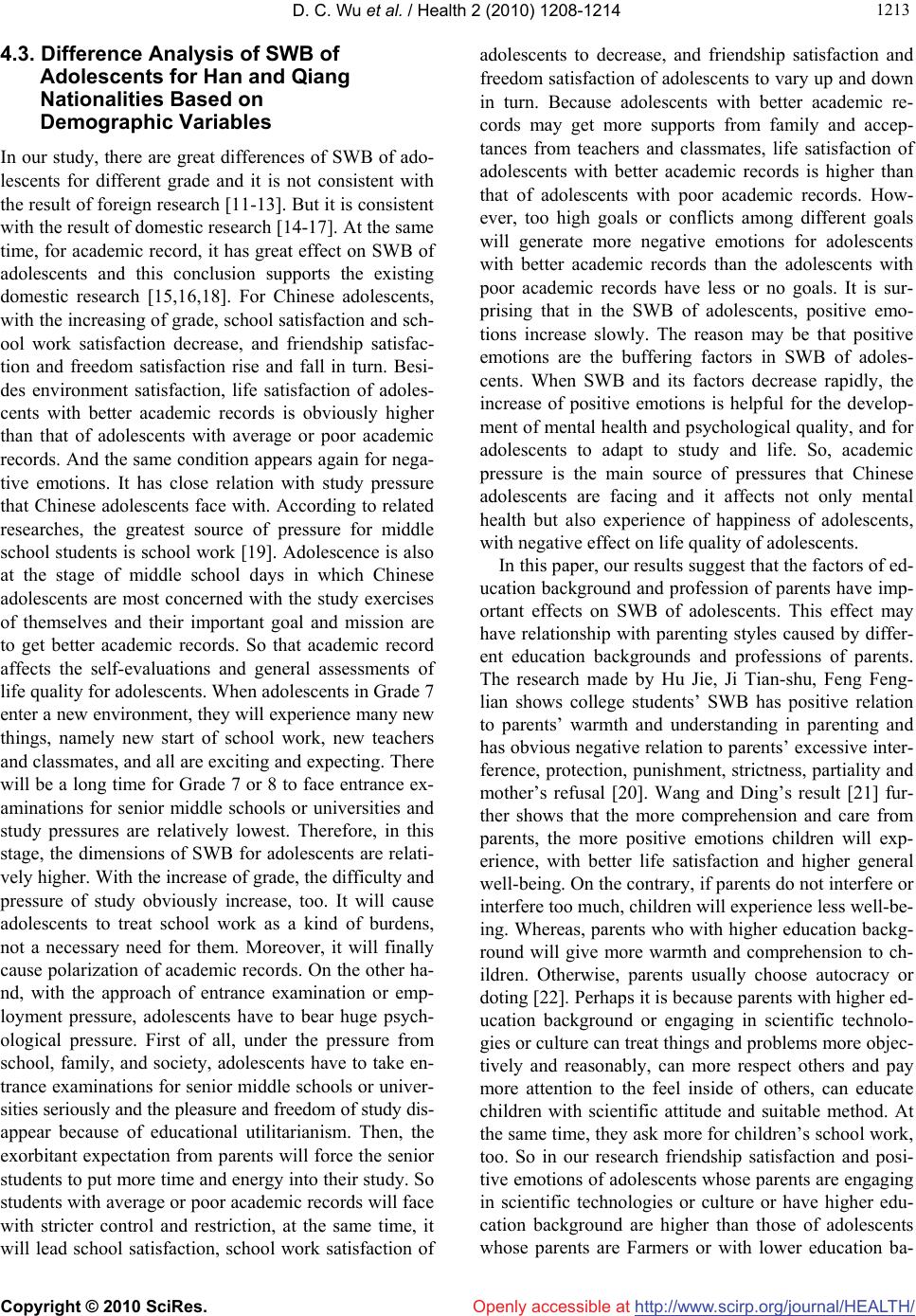 D. C. Wu et al. / Health 2 (2010) 1208-1214 Copyright © 2010 SciRes. Openly accessible at http://www.scirp.org/journal/HEALTH/ 121 1213 4.3. Difference Analysis of SWB of Adolescents for Han and Qiang Nationalities Based on Demographic Variables In our study, there are great differences of SWB of ado- lescents for different grade and it is not consistent with the result of foreign research [11-13]. But it is consistent with the result of domestic research [14-17]. At the same time, for academic record, it has great effect on SWB of adolescents and this conclusion supports the existing domestic research [15,16,18]. For Chinese adolescents, with the increasing of grade, school satisfaction and sch- ool work satisfaction decrease, and friendship satisfac- tion and freedom satisfaction rise and fall in turn. Besi- des environment satisfaction, life satisfaction of adoles- cents with better academic records is obviously higher than that of adolescents with average or poor academic records. And the same condition appears again for nega- tive emotions. It has close relation with study pressure that Chinese adolescents face with. According to related researches, the greatest source of pressure for middle school students is school work [19]. Adolescence is also at the stage of middle school days in which Chinese adolescents are most concerned with the study exercises of themselves and their important goal and mission are to get better academic records. So that academic record affects the self-evaluations and general assessments of life quality for adolescents. When adolescents in Grade 7 enter a new environment, they will experience many new things, namely new start of school work, new teachers and classmates, and all are exciting and expecting. There will be a long time for Grade 7 or 8 to face entrance ex- aminations for senior middle schools or universities and study pressures are relatively lowest. Therefore, in this stage, the dimensions of SWB for adolescents are relati- vely higher. With the increase of grade, the difficulty and pressure of study obviously increase, too. It will cause adolescents to treat school work as a kind of burdens, not a necessary need for them. Moreover, it will finally cause polarization of academic records. On the other ha- nd, with the approach of entrance examination or emp- loyment pressure, adolescents have to bear huge psych- ological pressure. First of all, under the pressure from school, family, and society, adolescents have to take en- trance examinations for senior middle schools or univer- sities seriously and the pleasure and freedom of study dis- appear because of educational utilitarianism. Then, the exorbitant expectation from parents will force the senior students to put more time and energy into their study. So students with average or poor academic records will face with stricter control and restriction, at the same time, it will lead school satisfaction, school work satisfaction of adolescents to decrease, and friendship satisfaction and freedom satisfaction of adolescents to vary up and down in turn. Because adolescents with better academic re- cords may get more supports from family and accep- tances from teachers and classmates, life satisfaction of adolescents with better academic records is higher than that of adolescents with poor academic records. How- ever, too high goals or conflicts among different goals will generate more negative emotions for adolescents with better academic records than the adolescents with poor academic records have less or no goals. It is sur- prising that in the SWB of adolescents, positive emo- tions increase slowly. The reason may be that positive emotions are the buffering factors in SWB of adoles- cents. When SWB and its factors decrease rapidly, the increase of positive emotions is helpful for the develop- ment of mental health and psychological quality, and for adolescents to adapt to study and life. So, academic pressure is the main source of pressures that Chinese adolescents are facing and it affects not only mental health but also experience of happiness of adolescents, with negative effect on life quality of adolescents. In this paper, our results suggest that the factors of ed- ucation background and profession of parents have imp- ortant effects on SWB of adolescents. This effect may have relationship with parenting styles caused by differ- ent education backgrounds and professions of parents. The research made by Hu Jie, Ji Tian-shu, Feng Feng- lian shows college students’ SWB has positive relation to parents’ warmth and understanding in parenting and has obvious negative relation to parents’ excessive inter- ference, protection, punishment, strictness, partiality and mother’s refusal [20]. Wang and Ding’s result [21] fur- ther shows that the more comprehension and care from parents, the more positive emotions children will exp- erience, with better life satisfaction and higher general well-being. On the contrary, if parents do not interfere or interfere too much, children will experience less well-be- ing. Whereas, parents who with higher education backg- round will give more warmth and comprehension to ch- ildren. Otherwise, parents usually choose autocracy or doting [22]. Perhaps it is because parents with higher ed- ucation background or engaging in scientific technolo- gies or culture can treat things and problems more objec- tively and reasonably, can more respect others and pay more attention to the feel inside of others, can educate children with scientific attitude and suitable method. At the same time, they ask more for children’s school work, too. So in our research friendship satisfaction and posi- tive emotions of adolescents whose parents are engaging in scientific technologies or culture or have higher edu- cation background are higher than those of adolescents whose parents are Farmers or with lower education ba-  D. C. Wu et al. / Health 2 (2010) 1208-1214 Copyright © 2010 SciRes. Openly accessible at http://www.scirp.org/journal/HEALTH/ 1214 ckground. For the same reason, school satisfaction of ad- olescents is contrary. On the other hand, parents are lab- ors or intellects, with great work pressure and tension. So they take less care of children compared with Farm- ers. Accordingly, family satisfaction of adolescents wh- ose parents are labors or intellects is lower than that of adolescent whose parents are Farmers. Overall, for the healthy growth of children, it will be meaningful for pa- rents to strengthen their self-cultivation and improve their self-quality, to know more of physiologic and me- ntal characteristics of children, to learn more of scien- tific methods to educate children. REFERENCES [1] Wu, M.X. (2000) Theoretical development of subjective well-being in the west for 30 years. Journal of Develop- ments in Psychology (China), 4, 23-28. [2] Diener, E. (1984) Subjective well-being. Journal of Psy- chological Bulletin, 95(3), 542-575. [3] Ren, Z.H. and Ye, Y.-D.(2006)Review on domestic and overseas researches of affecting factors of subjective well-being. Journal of Fujian Normal University (Phi- losophy and Social Sciences Edition) (China), 139(4), 152-158. [4] Mandler, J.M. (1992) How to build a baby: II. Concep- tual primitives. Journal of Psychological Review, 99(4), 587-604. [5] Zhang, X.G, He, L.G. and Zheng, X. (2004) Adolescent students life satisfaction: Its construct and scale devel- opment. Journal of Psychological Science (China), 27(5), 1257-1260. [6] Gu, Y.Y. and Luo, Y.J.(2009)Neural mechanism of sub- jective well-being. Journal of Advances in Psychological Science (China), 17(5), 957-963. [7] Wang, X.D., Wang, X.L. and Ma, H. (1999) Handbook of mental health scale. Enlarged Edition, Chinese Mental Health Magazine, Beijing. [8] Huebner, E.S., Drane, W. and Valois, R.F. (2002) Levels and demographic correlates of adolescent life Satisfac- tion Reports. Journal of School Psychology International, 21(3), 281-292. [9] Xiao, J.W. and Shi, G.X. (2005) A relative study of the senior high school students daily event, mental health, and sense of happiness. Journal of Hebei Normal Uni- versity Educational Science Edition, 7(2), 75-78. [10] Zhao, S.Y. (2006) A survey on subjective well-being of students in key high schools. Chinese Journal of Special Education, 69(3), 59-62. [11] Dew, T. and Huebner, E.S. (1994) Adolescents’ per- ceived quality of life: An exploratory investigation. Journal of School Psychology, 32(2), 185-199. [12] Huebner, E.S., Drane, W. and Valois, R.F. (2000) Levels and demographic correlates of adolescent life satisfaction repots. Journal of School Psychology International, 21(3), 281-292. [13] Gilman, R. and Huebner, E.S. (2003) A review of life satisfaction research with children and adolescents. Journal of School Psychology Quarterly, 2, 107-116. [14] Zang, X.-G., He, L.-G. and Jiao, L. (2007) The structural relationship among big five personality, demography variable and SWB. Journal of Psychological Develop- ment and Education (China), (1), 46-53. [15] Su, X. (2008) Relationship between subjective well- being and academic achievement of junior middle school students. Journal of Henan Medical College for Staff and Workers, 20(3), 278-276. [16] Zhang, X.Q. and Sun, C.X. (2009) A study subjective well-being of secondary school students. Journal of Youth & Juvenile Research (China), 69(1), 20-25. [17] Wang, G., Zang, D.J. and Liang, L. (2008) The devel- opment characteristics of high school students’ subjec- tive well-being and its relationship with academic self. Journal of Chinese Special Education, 101(11), 90-95. [18] Ma, Y. and Liu, D.Z. (2005) Middle school students learning subjective well-being and its major influencing factors. Journal of Psychological Development and Ed- ucation (China), (1), 74-79. [19] Lou, W.Q and Chi, I. (2002) The Stressors and psycho- logical well-being of senior secondary school students. Journal of Psychological Science (China), 23(2), 156-159. [20] Hu, J., Ji, T.S. and Feng, F.L. (2002) A study of rela- tionship between parental rearing patterns and general well-being of college students. Journal of Chinese Heal- th Psychology, 10(1), 16-17. [21] Wang, J.S and Ding, X.H. (2003) Relationship between subjective well-being and coping style of junior school student. Journal of Chinese Public Health, 11(2), 1181- 1182. [22] Song, H.M., Shen, J.H., and Li, B.W. and Xiang, X.Z. (2004) A study of relationship between parental educa- tion and parental rearing patterns of college students. Journal of Medical Journal of Chinese People Health, 16(9), 571-572. |

